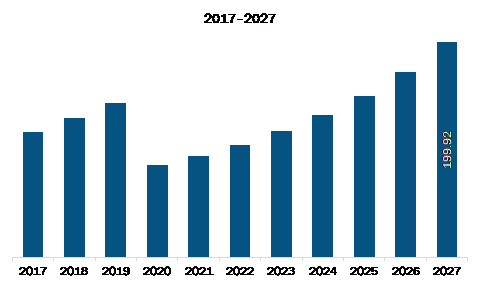The North America synchronous condenser market is expected to grow from US$ 189.95 million in 2019 to US$ 199.92 million by 2027; it is estimated to grow at a CAGR of 1.5 % from 2020 to 2027.
The US, Canada, and Mexico are major economies in North America. Rising demand for renewable power generation is expected to escalate the North America synchronous condenser market. The potential for rising demand for renewable energy, combined with the electrification of transportation and increased involvement of oil and gas companies in the electricity value chain, is accelerating the convergence of the above-mentioned industries. Rising initiatives among states, cities, and utilities to pursue DE carbonization plans over the years are increasing the demand for renewable energy across the North America. The energy production of most countries around the North America has been dominated by fossil fuels since the industrial revolution. This significantly affects both the climate and human health. The combustion of fossil fuels for electricity results in three-quarters of greenhouse gas emissions. In order to reduce carbon dioxide emission across the North America, the consumption of renewable energy has increased, leading to the high demand for the same. For instance, according to the International Renewable Energy Agency, the top North American country in terms of renewable power and electricity generation capacity is the US. Thus, rising investments in renewable power generation by major economies across the North America are expected to influence the adoption of synchronous condensers, which will drive the North America synchronous condenser market
Further, in case of COVID-19, North America is highly affected specially the US. North America has the highest adoption and growth levels of new technologies, with favorable government policies to boost innovation and improve infrastructure capabilities. Therefore, any effect on industries is expected to have a negative influence on the economic growth of the region. It is becoming apparent with the COVID-19 pandemic spreading across the US that few can escape its scope, presenting significant challenges to all industries. This had temporarily closed down all production plants across all industries and has also affected the supply chain and logistics industry of the country adversely. Though the demand for power was very high across the region especially arising from the healthcare sector to support all systems has influenced the rise in demand for renewable energy across the region. However, owing to nationwide lockdown across major economies like the US and Canada, the supply chain of major components of synchronous condenser was adversely affected, thereby impacted the manufacturing of the same. Thus, the above mentioned factors indicate that the outbreak of the pandemic has an adverse impact on the market across the region.
With the new features and technologies, vendors can attract new customers and expand their footprints in emerging markets. This factor is likely to drive the North America synchronous condenser market. The North America synchronous condenser market is expected to grow at a good CAGR during the forecast period.

- Sample PDF showcases the content structure and the nature of the information with qualitative and quantitative analysis.
- Request discounts available for Start-Ups & Universities
North America Synchronous Condenser Market Segmentation
- Sample PDF showcases the content structure and the nature of the information with qualitative and quantitative analysis.
- Request discounts available for Start-Ups & Universities
North America Synchronous Condenser Market – By Cooling Type
- Air-cooled
- Hydrogen-cooled
- Water-cooled
North America Synchronous Condenser Market – By Reactive Power Rating
- Up to 100 MVAr
- 100-200 MVAr
- Above 200 MVAr
North America Synchronous Condenser Market – By Starting Method
- Pony Motor
- Static Frequency Converter
- others
North America Synchronous Condenser Market – By Application
- Metal and Mining
- Electrical Utilities and Grid Operators
- Marine
- Oil and Gas
- Others
North America Synchronous Condenser Market, by Country
- US
- Canada
- Mexico
North America Synchronous Condenser Market -Companies Mentioned
- ABB Ltd.
- Brush Group
- Eaton Corporation plc
- FUJI ELECTRIC CO., LTD.
- General Electric Company
- IDEAL ELECTRIC POWER CO.
- Mitsubishi Electric Power Products, Inc. (Mitsubishi Electric Corporation)
- Siemens AG (Siemens Energy)
- Voith GmbH & Co. KGaA
- WEG ELECTRIC CORP.

Report Coverage
Revenue forecast, Company Analysis, Industry landscape, Growth factors, and Trends

Segment Covered
Cooling Type, Reactive Power Rating, Starting Method, and Application

Regional Scope
North America, Europe, Asia Pacific, Middle East & Africa, South & Central America

Country Scope
US, Canada
1. Introduction
1.1 Study Scope
1.2 The Insight Partners Research Report Guidance
1.3 Market Segmentation
2. Key Takeaways
3. Research Methodology
3.1 Coverage
3.2 Secondary Research
3.3 Primary Research
4. North America Synchronous Condenser Market Landscape
4.1 Market Overview
4.2 North America PEST Analysis
4.3 Ecosystem Analysis
4.4 Expert Opinion
5. North America Synchronous Condenser Market – Key Market Dynamics
5.1 Market Drivers
5.1.1 Rising Demand for Renewable Power Generation
5.1.2 Increasing Need for Power Factor Correction (PFC)
5.2 Market Restraints
5.2.1 High Costs of Synchronous Condensers
5.3 Market Opportunities
5.3.1 Changing the existing synchronous generators into synchronous condensers
5.4 Future Trends
5.4.1 Growing High-Voltage Direct Current (HVDC) Network
5.5 Impact Analysis of Drivers and Restraints
6. Synchronous Condenser Market – North America Analysis
6.1 North America Synchronous Condenser Market Overview
6.2 North America Synchronous Condenser Market – Revenue and Forecast to 2027 (US$ Million)
6.3 Market Positioning – Five Key Players
7. North America Synchronous Condenser Market Analysis – By Cooling Type
7.1 Overview
7.2 North America Synchronous Condenser Market, By Cooling Type (2019 and 2027)
7.3 Air-Cooled
7.3.1 Overview
7.3.2 Air-Cooled: Synchronous Condenser Market – Revenue and Forecast to 2027 (US$ Million)
7.4 Hydrogen-Cooled
7.4.1 Overview
7.4.2 Hydrogen-Cooled: Synchronous Condenser Market – Revenue and Forecast to 2027 (US$ Million)
7.5 Water-Cooled
7.5.1 Overview
7.5.2 Water-Cooled: Synchronous Condenser Market – Revenue and Forecast to 2027 (US$ Million)
8. North America Synchronous Condenser Market Analysis – By Reactive Power Rating
8.1 Overview
8.2 North America Synchronous Condenser Market Breakdown, by Reactive Power Rating, 2019 & 2027
8.3 Up to 100 MVAr
8.3.1 Overview
8.3.2 Up to 100 MVAr Market Revenue and Forecast to 2027 (US$ Million)
8.4-200 MVAr
8.4.1 Overview
8.4.2-200 MVAr Market Revenue and Forecast to 2027 (US$ Million)
8.5 Above 200 MVAr
8.5.1 Overview
8.5.2 Above 200 MVAr Market Revenue and Forecast to 2027 (US$ Million)
9. North America Synchronous Condenser Market Analysis – By Starting Method
9.1 Overview
9.2 North America Synchronous Condenser Market Breakdown, by Starting Method, 2019 & 2027
9.3 Pony Motor
9.3.1 Overview
9.3.2 Pony Motor Market Revenue and Forecast to 2027 (US$ Million)
9.4 Static Frequency Converter
9.4.1 Overview
9.4.2 Static Frequency Converter Market Revenue and Forecast to 2027 (US$ Million)
9.5 Others
9.5.1 Overview
9.5.2 Others Market Revenue and Forecast to 2027 (US$ Million)
10. North America Synchronous Condenser Market Analysis – By Application
10.1 Overview
10.2 North America Synchronous Condenser Market Breakdown, by Application, 2019 & 2027
10.3 Metal and Mining
10.3.1 Overview
10.3.2 Metal and Mining Market Revenue and Forecast to 2027 (US$ Million)
10.4 Electrical Utilities and Grid Operators
10.4.1 Overview
10.4.2 Electrical Utilities and Grid Operators Market Revenue and Forecast to 2027 (US$ Million)
10.5 Marine
10.5.1 Overview
10.5.2 Marine Market Revenue and Forecast to 2027 (US$ Million)
10.6 Oil and Gas
10.6.1 Overview
10.6.2 Oil and Gas Market Revenue and Forecast to 2027 (US$ Million)
10.7 Others
10.7.1 Overview
10.7.2 Others Market Revenue and Forecast to 2027 (US$ Million)
11. North America Synchronous Condenser Market – Country Analysis
11.1 Overview
11.1.1 North America: Synchronous Condenser Market, by Key Country
11.1.1.1 US: Synchronous Condenser Market – Revenue and Forecast to 2027 (US$ Million)
11.1.1.1.1 US: Synchronous Condenser Market, by Cooling Type
11.1.1.1.1.1 US: Synchronous Condenser Market, by Reactive Power Rating
11.1.1.1.2 US: Synchronous Condenser Market, by Starting Method
11.1.1.1.3 US: Synchronous Condenser Market, by Application
11.1.1.2 Canada: Synchronous Condenser Market – Revenue and Forecast to 2027 (US$ Million)
11.1.1.2.1 Canada: Synchronous Condenser Market, by Cooling Type
11.1.1.2.1.1 Canada: Synchronous Condenser Market, by Reactive Power Rating
11.1.1.2.2 Canada: Synchronous Condenser Market, by Starting Method
11.1.1.2.3 Canada: Synchronous Condenser Market, by Application
11.1.1.3 Mexico: Synchronous Condenser Market – Revenue and Forecast to 2027 (US$ Million)
11.1.1.3.1 Mexico: Synchronous Condenser Market, by Cooling Type
11.1.1.3.1.1 Mexico: Synchronous Condenser Market, by Reactive Power Rating
11.1.1.3.2 Mexico: Synchronous Condenser Market, by Starting Method
11.1.1.3.3 Mexico: Synchronous Condenser Market, by Application
12. Impact of COVID-19 Pandemic on North America Synchronous Condenser Market
12.1 North America: Impact Assessment of COVID-19 Pandemic
13. Industry Landscape
13.1 Overview
13.2 Market Initiative
13.3 New Product Development
14. Company Profiles
14.1 ABB Ltd.
14.1.1 Key Facts
14.1.2 Business Description
14.1.3 Products and Services
14.1.4 Financial Overview
14.1.5 SWOT Analysis
14.1.6 Key Developments
14.2 Brush Group
14.2.1 Key Facts
14.2.2 Business Description
14.2.3 Products and Services
14.2.4 Financial Overview
14.2.5 SWOT Analysis
14.2.6 Key Developments
14.3 Eaton Corporation plc
14.3.1 Key Facts
14.3.2 Business Description
14.3.3 Products and Services
14.3.4 Financial Overview
14.3.5 SWOT Analysis
14.3.6 Key Developments
14.4 FUJI ELECTRIC CO., LTD.
14.4.1 Key Facts
14.4.2 Business Description
14.4.3 Products and Services
14.4.4 Financial Overview
14.4.5 SWOT Analysis
14.4.6 Key Developments
14.5 General Electric Company
14.5.1 Key Facts
14.5.2 Business Description
14.5.3 Products and Services
14.5.4 Financial Overview
14.5.5 SWOT Analysis
14.5.6 Key Developments
14.6 IDEAL ELECTRIC POWER CO.
14.6.1 Key Facts
14.6.2 Business Description
14.6.3 Products and Services
14.6.4 Financial Overview
14.6.5 SWOT Analysis
14.6.6 Key Developments
14.7 Mitsubishi Electric Power Products, Inc. (Mitsubishi Electric Corporation)
14.7.1 Key Facts
14.7.2 Business Description
14.7.3 Products and Services
14.7.4 Financial Overview
14.7.5 SWOT Analysis
14.7.6 Key Developments
14.8 Siemens AG (Siemens Energy)
14.8.1 Key Facts
14.8.2 Business Description
14.8.3 Products and Services
14.8.4 Financial Overview
14.8.5 SWOT Analysis
14.8.6 Key Developments
14.9 Voith GmbH & Co. KGaA
14.9.1 Key Facts
14.9.2 Business Description
14.9.3 Products and Services
14.9.4 Financial Overview
14.9.5 SWOT Analysis
14.9.6 Key Developments
14.10 WEG ELECTRIC CORP.
14.10.1 Key Facts
14.10.2 Business Description
14.10.3 Products and Services
14.10.4 Financial Overview
14.10.5 SWOT Analysis
14.10.6 Key Developments
15. Appendix
15.1 About The Insight Partners
15.2 Word Index
LIST OF TABLES
Table 1. North America Synchronous Condenser Market – Revenue and Forecast to 2027 (US$ Million)
Table 2. US: Synchronous Condenser Market, by Cooling Type –Revenue and Forecast to 2027 (US$ Million)
Table 3. US: Synchronous Condenser Market, by Cooling Type –Revenue and Forecast to 2027 (US$ Million)
Table 4. US: Synchronous Condenser Market, by Starting Method –Revenue and Forecast to 2027 (US$ Million)
Table 5. US: Synchronous Condenser Market, by Application –Revenue and Forecast to 2027 (US$ Million)
Table 6. Canada: Synchronous Condenser Market, by Cooling Type –Revenue and Forecast to 2027 (US$ Million)
Table 7. Canada: Synchronous Condenser Market, by Cooling Type –Revenue and Forecast to 2027 (US$ Million)
Table 8. Canada: Synchronous Condenser Market, by Starting Method –Revenue and Forecast to 2027 (US$ Million)
Table 9. Canada: Synchronous Condenser Market, by Application –Revenue and Forecast to 2027 (US$ Million)
Table 10. Mexico: Synchronous Condenser Market, by Cooling Type –Revenue and Forecast to 2027 (US$ Million)
Table 11. Mexico: Synchronous Condenser Market, by Cooling Type –Revenue and Forecast to 2027 (US$ Million)
Table 12. Mexico: Synchronous Condenser Market, by Starting Method –Revenue and Forecast to 2027 (US$ Million)
Table 13. Mexico: Synchronous Condenser Market, by Application –Revenue and Forecast to 2027 (US$ Million)
Table 14. List of Abbreviation
LIST OF FIGURES
Figure 1. North America Synchronous Condenser Market Segmentation
Figure 2. North America Synchronous Condenser Market Segmentation – By Country
Figure 3. North America Synchronous Condenser Market Overview
Figure 4. Hydrogen-cooled Segment to Show Remarkable Traction During Forecast Period
Figure 5. Above 200 MVAr Segment to Show Remarkable Growth During Forecast Period
Figure 6. Static frequency converter Segment to Show Remarkable Growth During Forecast Period
Figure 7. Electrical Utilities and Grid Operators Segment to Show Remarkable Growth During Forecast Period
Figure 8. US Held Largest Share of North America Synchronous Condenser Market
Figure 9. North America – PEST Analysis
Figure 10. Ecosystem Analysis
Figure 11. Expert Opinion
Figure 12. North America Synchronous Condenser Market Impact Analysis of Drivers and Restraints
Figure 13. North America Synchronous Condenser Market – Revenue and Forecast to 2027 (US$ Million)
Figure 14. North America Synchronous Condenser Market Revenue Share, by Cooling Type (2019 and 2027)
Figure 15. North America Air-Cooled: Synchronous Condenser Market – Revenue and Forecast to 2027 (US$ Million)
Figure 16. North America Hydrogen-Cooled: Synchronous Condenser Market – Revenue and Forecast to 2027 (US$ Million)
Figure 17. North America Water-Cooled: Synchronous Condenser Market – Revenue and Forecast to 2027 (US$ Million)
Figure 18. North America Synchronous Condenser Market Breakdown, by Reactive Power Rating (2019 and 2027)
Figure 19. North America Up to 100 MVAr Market Revenue and Forecast to 2027(US$ Million)
Figure 20. North America 100-200 MVAr Market Revenue and Forecast to 2027(US$ Million)
Figure 21. North America Above 200 MVAr Market Revenue and Forecast to 2027(US$ Million)
Figure 22. North America Synchronous Condenser Market Breakdown, by Starting Method (2019 and 2027)
Figure 23. North America Pony Motor Market Revenue and Forecast to 2027(US$ Million)
Figure 24. North America Static Frequency Converter Market Revenue and Forecast to 2027(US$ Million)
Figure 25. North America Others Market Revenue and Forecast to 2027(US$ Million)
Figure 26. North America Synchronous Condenser Market Breakdown, by Application (2019 and 2027)
Figure 27. North America Metal and Mining Market Revenue and Forecast to 2027(US$ Million)
Figure 28. North America Electrical Utilities and Grid Operators Market Revenue and Forecast to 2027(US$ Million)
Figure 29. North America Marine Market Revenue and Forecast to 2027(US$ Million)
Figure 30. North America Oil and Gas Market Revenue and Forecast to 2027(US$ Million)
Figure 31. North America Others Market Revenue and Forecast to 2027(US$ Million)
Figure 32. North America: Synchronous Condenser Market Revenue Share, By Key Country (2019 and 2027)
Figure 33. US: Synchronous Condenser Market – Revenue and Forecast to 2027 (US$ Million)
Figure 34. Canada: Synchronous Condenser Market – Revenue and Forecast to 2027 (US$ Million)
Figure 35. Mexico: Synchronous Condenser Market – Revenue and Forecast to 2027 (US$ Million)
Figure 36. Impact of COVID-19 Pandemic in North American Country Markets
- ABB Ltd.
- Brush Group
- Eaton Corporation plc
- FUJI ELECTRIC CO., LTD.
- General Electric Company
- IDEAL ELECTRIC POWER CO.
- Mitsubishi Electric Power Products, Inc. (Mitsubishi Electric Corporation)
- Siemens AG (Siemens Energy)
- Voith GmbH & Co. KGaA
- WEG ELECTRIC CORP.
The Insight Partners performs research in 4 major stages: Data Collection & Secondary Research, Primary Research, Data Analysis and Data Triangulation & Final Review.
- Data Collection and Secondary Research:
As a market research and consulting firm operating from a decade, we have published many reports and advised several clients across the globe. First step for any study will start with an assessment of currently available data and insights from existing reports. Further, historical and current market information is collected from Investor Presentations, Annual Reports, SEC Filings, etc., and other information related to company’s performance and market positioning are gathered from Paid Databases (Factiva, Hoovers, and Reuters) and various other publications available in public domain.
Several associations trade associates, technical forums, institutes, societies and organizations are accessed to gain technical as well as market related insights through their publications such as research papers, blogs and press releases related to the studies are referred to get cues about the market. Further, white papers, journals, magazines, and other news articles published in the last 3 years are scrutinized and analyzed to understand the current market trends.
- Primary Research:
The primarily interview analysis comprise of data obtained from industry participants interview and answers to survey questions gathered by in-house primary team.
For primary research, interviews are conducted with industry experts/CEOs/Marketing Managers/Sales Managers/VPs/Subject Matter Experts from both demand and supply side to get a 360-degree view of the market. The primary team conducts several interviews based on the complexity of the markets to understand the various market trends and dynamics which makes research more credible and precise.
A typical research interview fulfils the following functions:
- Provides first-hand information on the market size, market trends, growth trends, competitive landscape, and outlook
- Validates and strengthens in-house secondary research findings
- Develops the analysis team’s expertise and market understanding
Primary research involves email interactions and telephone interviews for each market, category, segment, and sub-segment across geographies. The participants who typically take part in such a process include, but are not limited to:
- Industry participants: VPs, business development managers, market intelligence managers and national sales managers
- Outside experts: Valuation experts, research analysts and key opinion leaders specializing in the electronics and semiconductor industry.
Below is the breakup of our primary respondents by company, designation, and region:

Once we receive the confirmation from primary research sources or primary respondents, we finalize the base year market estimation and forecast the data as per the macroeconomic and microeconomic factors assessed during data collection.
- Data Analysis:
Once data is validated through both secondary as well as primary respondents, we finalize the market estimations by hypothesis formulation and factor analysis at regional and country level.
- 3.1 Macro-Economic Factor Analysis:
We analyse macroeconomic indicators such the gross domestic product (GDP), increase in the demand for goods and services across industries, technological advancement, regional economic growth, governmental policies, the influence of COVID-19, PEST analysis, and other aspects. This analysis aids in setting benchmarks for various nations/regions and approximating market splits. Additionally, the general trend of the aforementioned components aid in determining the market's development possibilities.
- 3.2 Country Level Data:
Various factors that are especially aligned to the country are taken into account to determine the market size for a certain area and country, including the presence of vendors, such as headquarters and offices, the country's GDP, demand patterns, and industry growth. To comprehend the market dynamics for the nation, a number of growth variables, inhibitors, application areas, and current market trends are researched. The aforementioned elements aid in determining the country's overall market's growth potential.
- 3.3 Company Profile:
The “Table of Contents” is formulated by listing and analyzing more than 25 - 30 companies operating in the market ecosystem across geographies. However, we profile only 10 companies as a standard practice in our syndicate reports. These 10 companies comprise leading, emerging, and regional players. Nonetheless, our analysis is not restricted to the 10 listed companies, we also analyze other companies present in the market to develop a holistic view and understand the prevailing trends. The “Company Profiles” section in the report covers key facts, business description, products & services, financial information, SWOT analysis, and key developments. The financial information presented is extracted from the annual reports and official documents of the publicly listed companies. Upon collecting the information for the sections of respective companies, we verify them via various primary sources and then compile the data in respective company profiles. The company level information helps us in deriving the base number as well as in forecasting the market size.
- 3.4 Developing Base Number:
Aggregation of sales statistics (2020-2022) and macro-economic factor, and other secondary and primary research insights are utilized to arrive at base number and related market shares for 2022. The data gaps are identified in this step and relevant market data is analyzed, collected from paid primary interviews or databases. On finalizing the base year market size, forecasts are developed on the basis of macro-economic, industry and market growth factors and company level analysis.
- Data Triangulation and Final Review:
The market findings and base year market size calculations are validated from supply as well as demand side. Demand side validations are based on macro-economic factor analysis and benchmarks for respective regions and countries. In case of supply side validations, revenues of major companies are estimated (in case not available) based on industry benchmark, approximate number of employees, product portfolio, and primary interviews revenues are gathered. Further revenue from target product/service segment is assessed to avoid overshooting of market statistics. In case of heavy deviations between supply and demand side values, all thes steps are repeated to achieve synchronization.
We follow an iterative model, wherein we share our research findings with Subject Matter Experts (SME’s) and Key Opinion Leaders (KOLs) until consensus view of the market is not formulated – this model negates any drastic deviation in the opinions of experts. Only validated and universally acceptable research findings are quoted in our reports.
We have important check points that we use to validate our research findings – which we call – data triangulation, where we validate the information, we generate from secondary sources with primary interviews and then we re-validate with our internal data bases and Subject matter experts. This comprehensive model enables us to deliver high quality, reliable data in shortest possible time.


 Get Free Sample For
Get Free Sample For